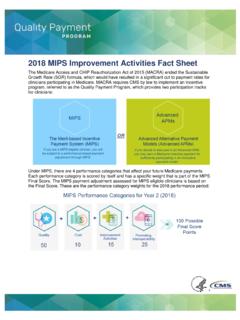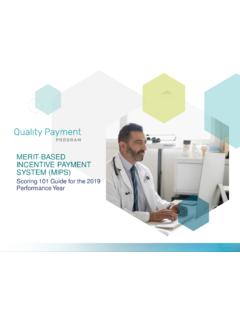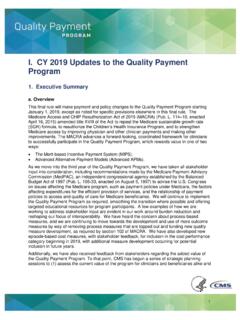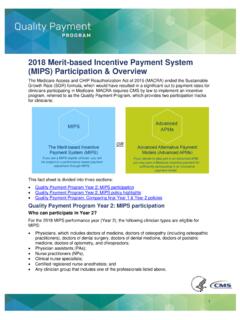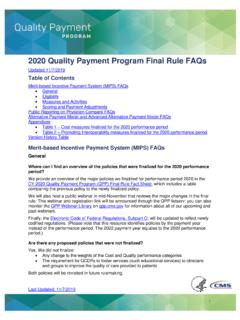Transcription of 2018 Merit-based Incentive Payment System (MIPS) Quality ...
1 1 2018 Merit-based Incentive Payment System (MIPS) Quality Performance Category: Claims Data Submission Fact sheet The Medicare Access and CHIP Reauthorization Act of 2015 (MACRA) ended the Sustainable Growth Rate (SGR) formula, which would have resulted in a significant cut to Payment rates for clinicians participating in Medicare. MACRA requires CMS by law to implement an Incentive program, referred to as the Quality Payment Program, which provides two participation tracks for clinicians: Merit-based Incentive Payment System (MIPS) Advanced Alternative Payment Models (Advanced APMs) Under MIPS, there are four performance categories that may affect your 2018 final score, and the MIPS Payment adjustment that applies to Medicare payments in the 2020 Payment year: 1.
2 Quality 2. Improvement Activities 3. Promoting Interoperability 4. Cost If you re eligible for MIPS in 2018, you generally have to submit data for the Quality , Improvement Activities, and Promoting Interoperability performance categories by March 31, 2019. If you are participating in MIPS as an individual clinician and you choose to use claims to submit Quality performance category data, you will attach Quality data codes to your claims throughout the 2018 performance year. The last day for submitting 2018 claims with Quality data codes for the 2018 performance period is determined by your Medicare Administrative Contractor (MAC) but must be processed 60 days after the close of the performance period.
3 Please check with your MAC for this guidance. (Please note that data submission is not required for the Cost performance category; CMS will calculate your cost measures using administrative claims data.) Your performance in these 4 categories will result in a final score, which in turn will determine whether you receive a negative, neutral, or positive MIPS Payment adjustment. For those MIPS eligible clinicians who choose to submit Quality performance category data via claims-based reporting, this fact sheet : Tells you how to submit data through your claims for the Quality performance category; and Gives you and your billing staff helpful data collection and submission tips.
4 2 MIPS Quality Performance Category Starting in 2018, there s a 12-month Quality performance period (January 1 December 31, 2018). In Year 2 of the Quality Payment Program, the Quality performance category is 50% of your overall MIPS final score. Clinicians, groups, and Virtual Groups should report the measures that are most meaningful to their practice and choose the submission mechanism that best meets their needs; not all Quality measures can be reported through all submission mechanisms. Under MIPS, there are 73 Quality measures that can be submitted through claims.
5 To fulfill the Quality performance category requirements via claims, a clinician must submit: Six Quality measures (or specialty measure set) for the 12-month performance period At least one outcome measure, or another high priority measure in the absence of an applicable outcome measure. Quality measures that meet case minimum requirements (20 cases) and data completeness requirements (60% in Year 2) are eligible for scoring against a benchmark and will earn 3 10 points based on performance as compared to the related benchmark. Please note that Quality measures submitted via claims are not eligible for the end-to-end electronic reporting bonus.
6 For additional information on MIPS scoring, please refer to the 2018 MIPS Scoring 101 Guide. MIPS Claims-based Data Submission Clinicians participating in MIPS as individuals can submit their Quality measures through claims. This submission mechanism is not an option when participating in MIPS as a group or Virtual Group. To submit Quality data through your claims, you have to: Select the MIPS claims Quality measures most meaningful to your practice Submit the measures through your regular billing processes by adding certain billing codes to denominator eligible claims If you choose to submit your Quality measure data through claims-based submission, you must first code your claim form for reimbursement.
7 If the claim meets the denominator criteria for the Quality measure chosen to submit, you will apply the corresponding Quality Data Codes (QDCs) found within the numerator of that Quality measure. The denominator of claims-based Quality measures includes ICD-10-CM, CPT Category I, and/or Healthcare Common Procedure Coding System (HCPCS) codes. These codes show which encounters should be included in the denominator of the Quality measure. Each Quality measure specification (found in the 2018 Resource Library) includes the code sets to identify denominator eligible encounters.
8 Note: CMS is establishing an annual review process to assess claims Quality measures impacted by ICD-10 code changes during the performance year. Significantly impacted measures will be assessed only on the first nine months (1/1-9/30) of the 2018 performance period because ICD-10 code changes are effective 10/1 of the 2018 performance period. 3 Each QDC(s) corresponds to a Quality action that could have occurred during the denominator eligible encounter. Choose the most appropriate Quality option for that denominator eligible encounter and apply that QDC(s) to your claim form.
9 QDCs may include Current Procedure Terminology (CPT) II codes (with or without modifiers) and/or G-codes for submission of Quality data in MIPS. The QDC(s) included on your claim form identify for CMS which claims-based Quality measure(s) you are submitting. As a Medicare provider, you submit claims through the CMS-1500 form or CMS-1450 (or the electronic version) to be paid for billable services given to Part B Fee-for-Service (FFS) beneficiaries that you ll bill for using your individual/rendering National Provider Identifier (NPI). When you submit your Quality data to CMS through your claims (claims will have QDC line items for each clinician s NPI), they ll be processed to final action by the Medicare Administrative Contractor (MAC).
10 All claims reimbursed are sent to the National Claims History (NCH). This is the data source that MIPS will use for measure analysis. Please keep in mind that claims can only be used for submitting measures in the Quality performance category; clinicians submitting Quality measures via claims need to select a different submission mechanism to submit their Promoting Interoperability data and Improvement Activities. 5 Steps for Claims-based Quality Measure Submission Step 1: Figure out if you re required to participate in MIPS For 2018, you re required to participate in MIPS if you: Are 1 of these types of clinicians.

